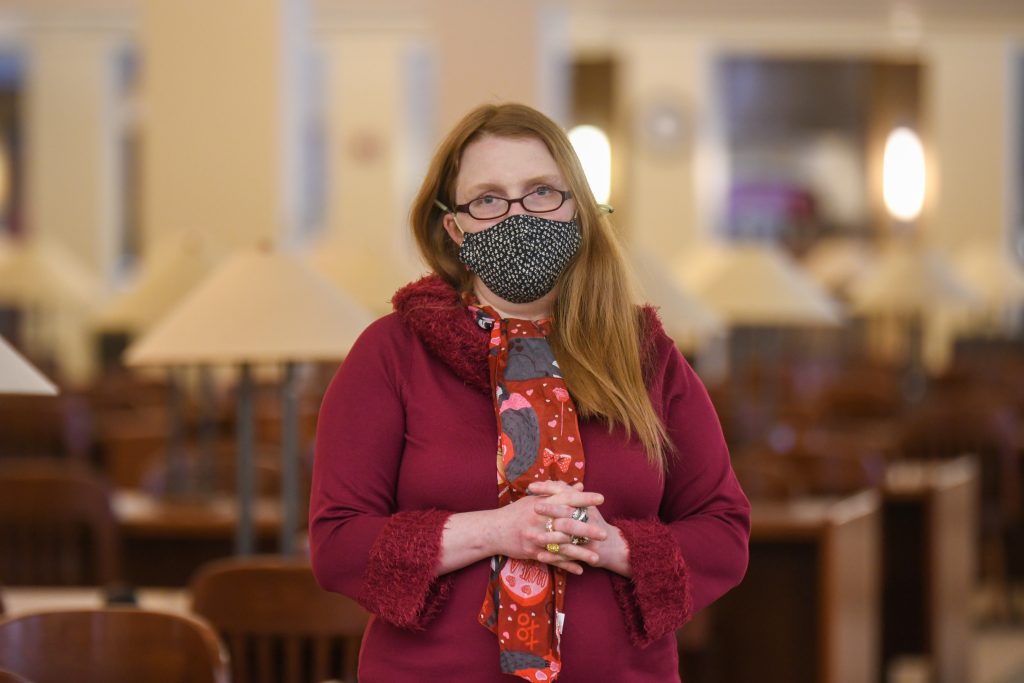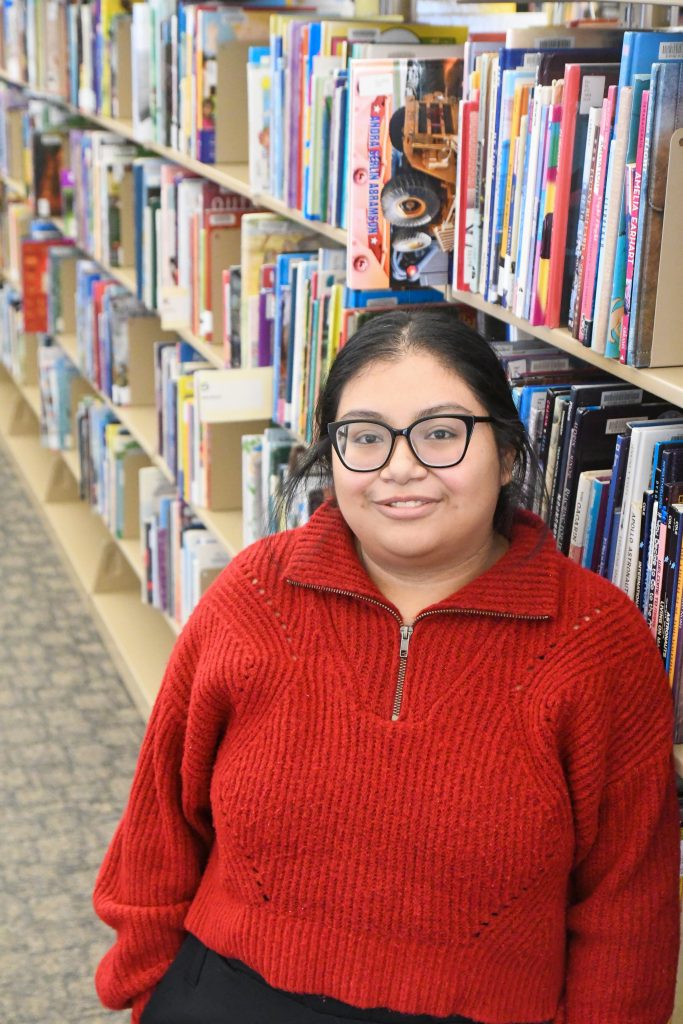St. Cloud State University Library finds the intersection between innovations in the classroom and improving the lives of students by making their classes more affordable through reducing textbook and material costs.
Jess VanderWerf is fortunate that she has very little she needs to invest in her classes outside of paying for her tuition and fees.
The graduate student’s course materials are often articles or open access materials in her Gerontology classes.
“In our program we aim to make it affordable by using articles,” she said. “We try to avoid using textbooks because who has that much extra.”
VanderWerf’s professors are innovating new ways of providing students with access to course materials that are affordable or accessible in ways beyond purchasing a textbook at the bookstore.
The zero-degree (Z-degree) movement seeks to make college more affordable for students by making sure they have no expenses beyond tuition and fees. Minnesota State’s community colleges have leaned into this movement in recent years creating many low or z-degree associate degree programs throughout the system.

Within a Z-degree framework, faculty use a variety of resources to support their courses, typically not using or depending on a traditional textbook offered at the campus bookstore. They instead make use of open access electronic textbooks, library materials or articles that can be accessed through open access databases or journals, or downloaded from the library.
St. Cloud State University is leading the effort at the university level as the first university in the system to be awarded an exploration grant as part of the Minnesota Z-Degree affordable courses model. At St. Cloud State, the university librarians who are leading the way by discovering options for affordable course materials and as part of a teacher-scholar effort on campus to empower their fellow faculty to investigate and incorporate affordable options into their classes, research and publishing.
University Library Dean Rhonda Huisman sees librarians at the center of the discussion on affordability. Librarians see and hear from students about the need to be prepared and the struggle to finance course materials. Librarians also understand the need for materials that match pedagogy and can help faculty explore alternative materials and figure out ways to make sure materials that aren’t open are accessible to students, she said.
St. Cloud State University Library launched its efforts in affordable textbooks in 2018 assisted by a 2019 grant from the Minnesota State system. The system awarded $80,000 to four institutions, including St. Cloud State, to develop Open Educational Resource teams to support faculty cohorts developing open educational resources in their courses.
Nineteen St. Cloud State faculty members participated, including Library faculty, two of whom ended up writing their own textbook for a course as part of the grant.
Textbooks becoming out of reach
According to Education Data Initiative, the average cost of textbooks and supplies for an undergraduate student is $1,200 per year. Since 1977, the price of textbooks has increased more than 1,000 percent. A study conducted by the Student Public Interest Research Groups in 2014 found that most students have refrained from buying a textbook because it was too expensive and almost half said that the cost of textbooks impacted their decision on which courses to take.
“For some students, they can’t do it. They don’t buy the book, and then they’re behind.” Huisman said. “The student then comes to class unprepared. They have other things they need to spend their money on — rent, food, survival, daycare, gas for their car.”
Through the It’s Time initiative St. Cloud State is leaning into higher education’s role as the great equalizer that creates opportunities for economic and social mobility for students. Affordable course materials are a big part of that commitment to provide access to low-income students, Huisman said.
Z-degree efforts come at a time when the textbook industry is changing in ways that make purchasing a book more convenient, but also more frustrating and expensive for students, said Jennifer Quinlan, St. Cloud State associate professor and student success librarian.
The textbook publishers are trying to make sure everyone is buying a textbook by including codes, which are the only way students can access special online materials such as homework and quizzes. The codes are only good for the semester. So, a student can’t share books with a classmate, sell their book after they are done or even re-use it if they need to retake the class, she said.
“The code is as expensive as the textbook,” Quinlan said. “That just makes me angry, and we plan to do more programming and education around textbook myths.”
Quinlan is learning about open access resources and has participated in facilitating the Minnesota State grant. Now she is sharing what she knows with faculty across campus by leading the Affordability Learning Circle once a month to get faculty across campus thinking about options and resources for making their courses more affordable. This summer librarians are developing a boot-camp style workshop for faculty for the upcoming academic year.
Student-led effort
St. Cloud State librarians began working on affordable textbooks in 2018 after hearing from students and learning from their community college colleagues, Huisman said.

With 30% of St. Cloud State undergraduates transferring in with existing degrees or credits, students come to campus knowing the impact of Z-degrees at community college and noticing the lack of these options on campus. Students are advocating for a change. Simultaneously, St. Cloud State librarians saw the need to shift what is happening at four-year institutions.
“We need to provide materials for students in a way that is more far reaching than just open access,” Huisman said. “We needed to figure out how to get these textbooks on the bookshelves in the library.”
Partnering with Student Government, one of the library’s first efforts at promoting affordability was creating the Textbook Affordability Project for Success (TAPS) program, which puts textbooks on reserve in the library for students to check out for two hours at a time – giving students who can’t purchase a book access to the materials they need for their classes.
The program now has more than 1,000 items on reserve for students to check out in their courses in 570 course sections. The program has saved students an estimated $8 million in textbook costs since the program began. The cost per text at St. Cloud State has decreased from $190 in 2018 to $154 today, with those savings coming in many ways from faculty adopting textbooks for more than one year and choosing texts or materials that are affordable, Huisman said.
St. Cloud State is one of Minnesota State institutions collaborating on a three-year almost $1 million U.S. Department of Education grant to establish the Opening Opportunities for Education program, which creates open textbooks and open educational research for core teacher education courses for students studying to be teachers.
The grant estimates that the switch to open resources will save students $500 per year on textbooks for a total annual savings for Minnesota State teacher education students of about $600,000 per year.
Affordable e-books
In the last two years the library has added 197,000 e-books to the univeristy’s resources for students and faculty to access. More than 30 faculty are using e-books as their texts, which are fully downloadable and can be integrated into D2L and printed or used with a screen reader.
Open access e-books are also leading the way on making materials accessible for students with disabilities, Huisman said.
Open access textbooks can be edited by the students themselves to expand the print size or be read with electronic readers without any added costs. Other library resources benefit from those same advantages.
“If faculty adopt library resources, we have some resources that will read the article, or , if you have low vision, screen-reading software that can assist a student in downloading an article in a different format, or even listen to it on their commute,” Huisman said.
Master of Public Administration professor Dr. Shawn Schooley, Dr. Jim Cottrill and Dr. Shoan Yang are working on developing their own open textbook “Minnesota Government and Politics” along with their co-editors.
Schooley and his colleagues took over editing the book in 2018. They collaborated with other Minnesota State faculty and other Minnesota officials to write chapters in the books. They wanted to make it open access and electronic at the time, but didn’t know how. Instead they worked with a company that could create it as a textbook at the lowest cost possible — $75 per book.
They are now working with Quinlan who introduced them to Press Books and are learning the software, so they can release the next edition as open access with the goal of publishing this fall.

Heart of campus
Beyond affordability, the library remains the heart of campus at St. Cloud State University where students see it as a refuge of quiet and relaxation, said Kristi Trujillo, a senior double major in Psychology and Business Management.
The library is a refuge for students who can go there any time to seek assistance or a quiet place to study.
“Freshman year I spent a lot of time at the library,” Trujillo said. “By now I know the study rooms and the hidden study rooms. I really love reading too.”
“It’s a place where I can study quietly and not have distractions,” she said. “Especially with having a learning disability, I found it’s nice to have my own area where I know what works and having the sound where I want it helps a lot because I come from home with two younger siblings.”
Trujillo also finds the library is a place where she can host study sessions with friends, do a literature review, read a book in a quiet corner, or check out multimedia equipment that is needed for a special class assignment.
“It’s a good place if you want to clear your mind for a bit and be on your phone and scroll, there’s lots of places to be here in the library,” she said.
Trujillo is a member of the Student Library Advisory Board, which plans events for the library, leads textbook drives and advises library administration on new opportunities they see within the library.
One issue Trujillo is passionate about is accessibility for students with disabilities.
“There’s always something going on at the library that can be used as a tool to help you succeed,” said VanderWerf, who also serves on the Student Advisory Board. “Students that don’t use the library, I just worry about because all the answers are here. It’s pretty great.”
Librarians are also there to help students understand the information they’re reading and seeing.
“There’s this perception that exists that there’s no need for the library because everything is just so easy to find and this generation, they know how to use technology,” Quinlan said. “But the difference between now and 20 years ago is that getting access to information is overwhelming. There’s so much information out there, but a lot of times it’s the same information just repeating itself.”
Students need help to find the original source and to evaluate the information their finding to be sure they aren’t being tricked or persuaded by it, she said.
“My colleague and I teach critical thinking and academic research courses. The library can give you a set of tools to help make research easier,” Quinlan said. ”We can reach students wherever they are, and we can help them. The library is there for them 24/7. We’re also here to support faculty and help them in their teaching and research.”
